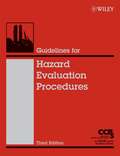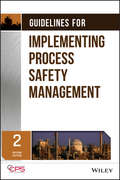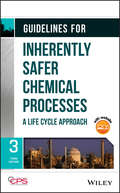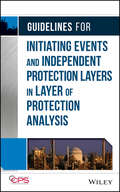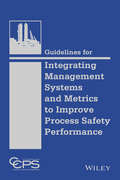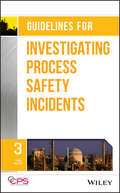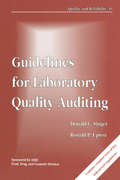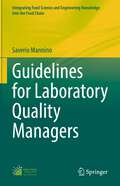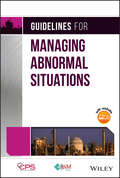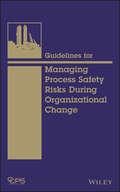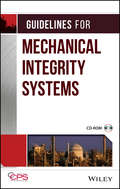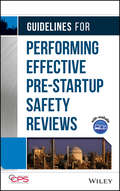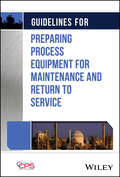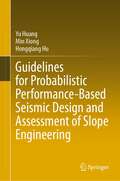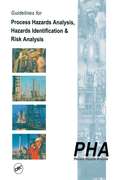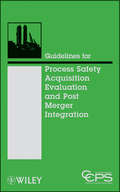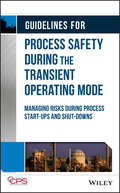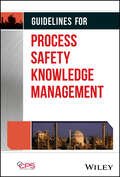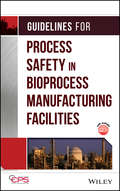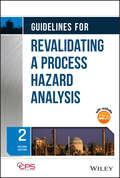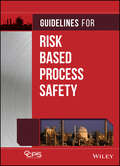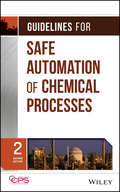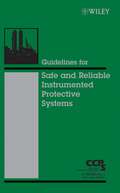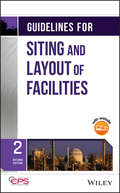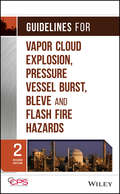- Table View
- List View
Guidelines for Hazard Evaluation Procedures
by Center For Chemical Process SafetyGuidelines for Hazard Evaluation Procedures, 3rd Edition keeps process engineers updated on the effective methodologies that process safety demands. Almost 200 pages of worked examples are included to facilitate understanding. References for further reading, along with charts and diagrams that reflect the latest views and information, make this a completely accessible work. The revised and updated edition includes information not included in previous editions giving a comprehensive overview of this topic area.
Guidelines for Implementing Process Safety Management
by CcpsThe 2nd edition provides an update of information since the publication of the first edition including best practices for managing process safety developed by industry as well as incorporate the additional process safety elements. In addition the book includes a focus on maintaining and improving a Process Safety Management (PSM) System. This 2nd edition also provides "how to information to" determine process safety performance status, implement one or more new elements into an existing PSM system, maintain or improve an existing PSM system, and manage future process safety performance.
Guidelines for Inherently Safer Chemical Processes: A Life Cycle Approach
by CcpsSince the publication of the second edition several United States jurisdictions have mandated consideration of inherently safer design for certain facilities. Notable examples are the inherently safer technology (IST) review requirement in the New Jersey Toxic Chemical Prevention Act (TCPA), and the Inherently Safer Systems Analysis (ISSA) required by the Contra Costa County (California) Industrial Safety Ordinance. More recently, similar requirements have been proposed at the U.S. Federal level in the pending EPA Risk Management Plan (RMP) revisions. Since the concept of inherently safer design applies globally, with its origins in the United Kingdom, the book will apply globally. The new edition builds on the same philosophy as the first two editions, but further clarifies the concept with recent research, practitioner observations, added examples and industry methods, and discussions of security and regulatory issues. Inherently Safer Chemical Processes presents a holistic approach to making the development, manufacture, and use of chemicals safer. The main goal of this book is to help guide the future state of chemical process evolution by illustrating and emphasizing the merits of integrating inherently safer design process-related research, development, and design into a comprehensive process that balances safety, capital, and environmental concerns throughout the life cycle of the process. It discusses strategies of how to: substitute more benign chemicals at the development stage, minimize risk in the transportation of chemicals, use safer processing methods at the manufacturing stage, and decommission a manufacturing plant so that what is left behind does not endanger the public or environment.
Guidelines for Initiating Events and Independent Protection Layers in Layer of Protection Analysis
by CcpsThe book is a guide for Layers of Protection Analysis (LOPA) practitioners. It explains the onion skin model and in particular, how it relates to the use of LOPA and the need for non-safety instrumented independent protection layers. It provides specific guidance on Independent Protection Layers (IPLs) that are not Safety Instrumented Systems (SIS). Using the LOPA methodology, companies typically take credit for risk reductions accomplished through non-SIS alternatives; i.e. administrative procedures, equipment design, etc. It addresses issues such as how to ensure the effectiveness and maintain reliability for administrative controls or "inherently safer, passive" concepts. This book will address how the fields of Human Reliability Analysis, Fault Tree Analysis, Inherent Safety, Audits and Assessments, Maintenance, and Emergency Response relate to LOPA and SIS. The book will separate IPL's into categories such as the following: Inherent Safety eliminates a scenario or fundamentally reduces a hazard Preventive/Proactive prevents initiating event from occurring such as enhanced maintenance Preventive/Active stops chain of events after initiating event occurs but before an incident has occurred such as high level in a tank shutting off the pump. Mitigation (active or passive) minimizes impact once an incident has occurred such as closing block valves once LEL is detected in the dike (active) or the dike preventing contamination of groundwater (passive).
Guidelines for Integrating Management Systems and Metrics to Improve Process Safety Performance
by CcpsThis book combines the synergies between performance improvement systems to help ensure safe and reliable operations, streamline procedures and cross-system auditing, and supporting regulatory and corporate compliance requirements. Many metrics are common to more than one area, such that a well-designed and implemented integrated management system will reduce the load on the Process Safety, SHE, Security and Quality groups, and improve manufacturing efficiency and customer satisfaction. Systems to improve performance include: process safety; traditional safety, health and environment; and, product quality. Chapters include: Integrating Framework; Securing Support & Preparing for Implementation; Establishing Common Risk Management Systems - How to Integrate PSM into Other EH; Testing Implementation Approach; Developing and Agreeing on Metrics; Management Review; Tracking Integration Progress and Measuring Performance; Continuous Improvement; Communication of Results to Different Stakeholders; Case Studies; and Examples for Industry
Guidelines for Investigating Process Safety Incidents
by CcpsThis book provides a comprehensive treatment of investing chemical processing incidents. It presents on-the-job information, techniques, and examples that support successful investigations. Issues related to identification and classification of incidents (including near misses), notifications and initial response, assignment of an investigation team, preservation and control of an incident scene, collecting and documenting evidence, interviewing witnesses, determining what happened, identifying root causes, developing recommendations, effectively implementing recommendation, communicating investigation findings, and improving the investigation process are addressed in the third edition. While the focus of the book is investigating process safety incidents the methodologies, tools, and techniques described can also be applied when investigating other types of events such as reliability, quality, occupational health, and safety incidents.
Guidelines for Laboratory Quality Auditing (Quality and Reliability)
by Doanld C. Singer Ronald P. UptonThis single-source reference provides practical guidance for the quality auditing of a chemical or biological testing laboratory-helping to develop or improve quality control and quality assurance programs in order to meet certification standards or pass external-source audits.
Guidelines for Laboratory Quality Managers (Integrating Food Science and Engineering Knowledge Into the Food Chain #14)
by Saverio ManninoThis useful and extensive set of guidelines is designed to assist food control laboratories in gaining accreditation from an internationally recognized external body, providing all of the necessary information and practices in an easy-to-read, step-by-step fashion. Authored by an experienced consultant for laboratory accreditation in many different countries, with this text food control lab owners now have all of the up-to-date information they need to gain accreditation in a single source. Guidelines for Laboratory Quality Managers covers the essentials for quality management in the food control laboratory, from testing processes to current quality management systems. The ISO standards for accreditation are extensively explored, including managerial requirements, organizational aspects, complaint handling procedures, internal audits, and sampling. An entire section is dedicated to the implementation of managerial and technical requirements from quality control to program monitoring and evaluation. Analysis selection, preparation, and validation is covered extensively, and an entire section is dedicated to basic statistics from data presentation to distribution. Each section comes with helpful tips for lab managers plus definitions and terms. Comprehensive, easy-to-use and up-to-date, Guidelines for Laboratory Quality Managers is the guide for accreditation for food control laboratories.
Guidelines for Managing Abnormal Situations
by CCPS (Center for Chemical Process Safety)GUIDELINES FOR MANAGING ABNORMAL SITUATIONS
Guidelines for Managing Process Safety Risks During Organizational Change, 1st Edition
by CcpsAn understanding of organizational change management (OCM) -- an often overlooked subject -- is essential for successful corporate decision making with little adverse effect on the health and safety of employees or the surrounding community. Addressing the myriad of issues involved, this book helps companies bring their OCM systems to the same degree of maturity as other process safety management systems. Topics include corporate standard for organizational change management, modification of working conditions, personnel turnover, task allocation changes, organizational hierarchy changes, and organizational policy changes.
Guidelines for Mechanical Integrity Systems
by CCPS (Center for Chemical Process Safety)In recent years, process safety management system compliance audits have revealed that organizations often have significant opportunities for improving their Mechanical Integrity programs. As part of the Center for Chemical Process Safety's Guidelines series, Guidelines for Mechanical Integrity Systems provides practitioners a basic familiarity of mechanical integrity concepts and best practices. The book recommends efficient approaches for establishing a successful MI program.
Guidelines for Performing Effective Pre-Startup Safety Reviews
by CcpsThis book provides guidance to those with responsibility for scheduling and executing a Pre-Startup Safety Review (PSSR). It outlines a protocol and tool for use by project or turnaround teams, to effectively and efficiently schedule and execute a PSSR. Integrates PSSR throughout the project/turnaround phases, with a verification check at the traditional PSSR step Supports a "right first time" and "check only once" project philosophy to eliminate surprises Features how-to checklists, hazard assessment, batch and continuous processes, validation, and documentation Includes a CD with PSSR checklists and PSSR management system examples. Note: CD-ROM/DVD and other supplementary materials are not included as part of eBook file.
Guidelines for Preparing Process Equipment for Maintenance and Return to Service
by CCPS (Center for Chemical Process Safety)This book contains comprehensive information and methodologies for preparing process equipment for maintenance and, ultimately, return to service. Specifically, this book addresses two phases of equipment handovers, providing information and tools to help personnel at manufacturing sites reduce their risks. The first phase is isolating and preparing equipment for maintenance. The second phase is returning the equipment back to service, applying specified operational readiness plans in addition to a traditional pre-startup safety review (PSSR). Topics include understanding the unique types of hazards personnel might be exposed to, planning for and executing decontamination and de-energization plans, and safely recommissioning the equipment for its return to service. Case studies, examples, and incident investigation discussions provide the reader with invaluable practical learnings that, when applied, help reduce the likelihood of another similar operational incident from occurring at their facility.
Guidelines for Probabilistic Performance-Based Seismic Design and Assessment of Slope Engineering
by Yu Huang Min Xiong Hongqiang HuThis book provides a new design and evaluation framework based on slope Stochastic Dynamics theory to probabilistic seismic performance for slope engineering. For the seismic dynamic stability safety of slope, it shifts from deterministic seismic dynamic analysis to quantitative analysis based on nonlinear stochastic dynamics, that is, from qualitative to the description of stochasticity of earthquake excitation that meet the needs in related design specification and establish a performance standard. In the nonlinear dynamic time history analysis of slope subjected to seismic ground motion, the term “randomness” is used to express the uncertainty in the intensity and frequency of earthquake excitation for slope engineering dynamic seismic performance. It mainly includes seismic design fortification standard, corresponding ground motion excitation, performance index threshold, and slope deterministic nonlinear seismic dynamic response. Even more than that, the seismic dynamic large deformation approaches of the whole process and comprehensive analysis for flow analysis after slope instability failure. Eventually, the probabilistic seismic dynamic performance of the slope engineering will be characterized by nonlinear dynamic reliability.
Guidelines for Process Hazards Analysis (PHA, HAZOP), Hazards Identification, and Risk Analysis
by Nigel HyattThis unique manual is a comprehensive, easy-to-read overview of hazards analysis as it applies to the process and allied industries. The book begins by building a background in the technical definition of risk, past industrial incidents and their impacts, ensuing legislation, and the language and terms of the risk field. It addresses the different types of structured analytical techniques for conducting Process Hazards Analyses (PHA), provides a "What If" checklist, and shows how to organize and set up PHA sessions. Other topics include layout and siting considerations, Failure Modes and Effect Analysis (FMEA), human factors, loss of containment, and PHA team leadership issues.
Guidelines for Process Safety Acquisition Evaluation and Post Merger Integration, 1st Edition
by CcpsIt is crucial for process safety professionals to be aware of best practices for post merger integration at any level. A compilation of industry best practices from both technical and financial perspectives, this book provides a single reference that addresses acquisitions and merger integration issues related to process safety. Presently, there are limited references on how to handle acquisitions in several different CCPS publications and almost no coverage of the post-merger integration issue, so this reference fills a notable gap in the coverage.
Guidelines for Process Safety During the Transient Operating Mode: Managing Risks during Process Start-ups and Shut-downs
by CCPS (Center for Chemical Process Safety)Prevent operational incidents and reduce risks with an essential CCPS guide You can help your company reduce its operating risks by learning how to effectively manage transient operations and avoid major incidents. Startups and shutdowns, known as transient operations, can be high-risk periods for manufacturing facilities. Guidelines for Process Safety During Transient Operations offers useful guidance in preparing for the safe startup and shutdown of chemical processes. With an understanding of the risks involved, you can work proactively to prevent fatalities, serious injuries, reduced productivity, and costly damage. This essential guide for plants provides clear examples of how to anticipate and avoid major issues. The book examines safe shutdown procedures in the event of an emergency. You will also gain direction on how to resume operations safely after an unexpected shutdown. The book supports anyone tasked with regulating and overseeing chemical plants and procedures, whether you are an engineer, manager, or government professional. Minimize operating risks through the effective management of transient operations Establish safe start-up and shutdown procedures for chemical processes Be ready to safely shut down processes in the event of an emergency Learn from real world examples of start-up or shutdown incidents Review procedures and engineering controls that help prevent or reduce the effects of incidents involving transient operations Guidelines for Process Safety comes to you from The Center for Chemical Process Safety (CCPS), which offers advanced thinking in the critical area of process safety. The organization develops technology and management practices for companies seeking to reduce hazards within the chemical and petrochemical industries.
Guidelines for Process Safety Knowledge Management
by CCPS (Center for Chemical Process Safety)Use this guideline to develop an effective Process Safety Knowledge Management system When managing the risks of hazardous materials and energies, a well-developed process safety program is critical for maintaining a healthy workforce, for protecting the environment, and for sustaining the business. The Center for Chemical Process Safety (CCPS) has identified Process Knowledge Management as one of its twenty Elements in its Risk Based Process Safety (RBPS) approach. With an effective Process Safety Knowledge Management (PSKM) system, an organization will be able to capture, organize, maintain, and access its technical, engineering, and administrative information. Thus, an effective PSKM system will help an organization successfully manage its risks. This book provides a set of comprehensive guidelines for implementing a Process Safety Knowledge Management (PSKM) system, which will help an organization improve its process safety performance. The book begins with a discussion on the characteristics of a PSKM system. Then it describes the underlying factors for successful implementation and ends with guidance on overcoming common implementation difficulties. Produced by a leading global process safety organization, this book is essential for any organization looking to ensure that systems are in place to sustain their process safety knowledge during the life of the process. Guidelines for Process Safety Knowledge Management readers will also find: Case studies throughout the book, with PSKM-related lessons Detailed discussions of how a PSKM system helps cultivate leadership, improves organizational culture, and involves employees A business case for PSKM, demonstrating the benefits to the business Guidelines for Process Safety Knowledge Management is ideal for process safety professionals, engineering managers, facility managers, maintenance managers, production managers, and others responsible for creating or managing their process safety knowledge management systems.
Guidelines for Process Safety in Bioprocess Manufacturing Facilities
by Center For Chemical Process SafetyThis book helps advance process safety in a key area of interest. Currently, no literature exists which is solely dedicated to process safety for the bioprocessing industry. There are texts, guidelines, and standards on biosafety at the laboratory level and for industrial hygiene, but no guidelines for large-scale production facilities. In fact, biosafety is largely defined as a field that promotes safe laboratory practices, procedures and use of containment equipment and facilities. Additionally, biomedical engineers, biologists, or other professionals without chemical engineering training or knowledge of inherently safe design are designing many of these facilities.
Guidelines for Revalidating a Process Hazard Analysis
by CCPS (Center for Chemical Process Safety)GUIDELINES FOR REVALIDATING A PROCESS HAZARD ANALYSIS
Guidelines for Risk Based Process Safety
by CCPS (Center for Chemical Process Safety)Guidelines for Risk Based Process Safety provides guidelines for industries that manufacture, consume, or handle chemicals, by focusing on new ways to design, correct, or improve process safety management practices. This new framework for thinking about process safety builds upon the original process safety management ideas published in the early 1990s, integrates industry lessons learned over the intervening years, utilizes applicable "total quality" principles (i.e., plan, do, check, act), and organizes it in a way that will be useful to all organizations - even those with relatively lower hazard activities - throughout the life-cycle of a company.
Guidelines for Safe Automation of Chemical Processes
by CcpsThis book provides designers and operators of chemical process facilities with a general philosophy and approach to safe automation, including independent layers of safety. An expanded edition, this book includes a revision of original concepts as well as chapters that address new topics such as use of wireless automation and Safety Instrumented Systems. This book also provides an extensive bibliography to related publications and topic-specific information.
Guidelines for Safe and Reliable Instrumented Protective Systems
by CcpsThis book explains the decision-making processes for the management of instrumented protective systems (IPS) throughout a project's life cycle. It uses the new IEC 61511 standard as a basis for the work processes used to achieve safe and reliable process operation. By walking the reader through a project's life cycle, engineering, maintenance, and operations, the information allows users to easily focus on their responsibilities and duties. Using this approach, the book is useful as a primer, guidelines reference, and resource manual. Examples provide the added "real-world" experience applications.
Guidelines for Siting and Layout of Facilities
by CcpsThis book has been written to address many of the developments since the 1st Edition which have improved how companies survey and select new sites, evaluate acquisitions, or expand their existing facilities. This book updates the appendices containing both the recommended separation distances and the checklists to help the teams obtain the information they need when locating the facility within a community, when arranging the processes within the facility, and when arranging the equipment within the process units.
Guidelines for Vapor Cloud Explosion, Pressure Vessel Burst, BLEVE, and Flash Fire Hazards
by CcpsThis guide provides an overview of methods for estimating the characteristics of vapor cloud explosions, flash fires, and boiling-liquid-expanding-vapor explosions (BLEVEs) for practicing engineers. It has been updated to include advanced modeling technology, especially with respect to vapor cloud modeling and the use of computational fluid dynamics. The text also reviews past experimental and theoretical research and methods to estimate consequences. Heavily illustrated with photos, charts, tables, and diagrams, this manual is an essential tool for safety, insurance, regulatory, and engineering students and professionals.
